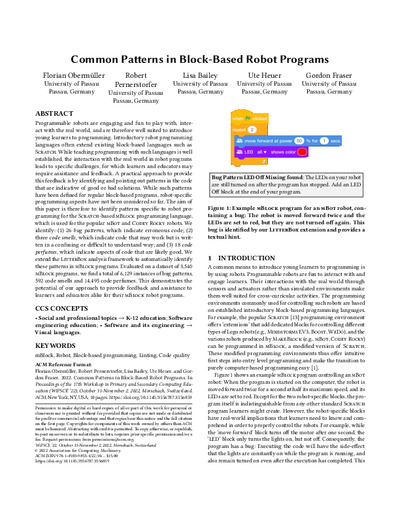Common Patterns in Block-Based Robot Programs Publikationsdatum:
Zu finden in: WiPSCE '22, 2022
 |
 |
 Diese Seite wurde seit 2 Jahren inhaltlich nicht mehr aktualisiert.
Unter Umständen ist sie nicht mehr aktuell.
Diese Seite wurde seit 2 Jahren inhaltlich nicht mehr aktualisiert.
Unter Umständen ist sie nicht mehr aktuell.
 Zusammenfassungen
Zusammenfassungen


Programmable robots are engaging and fun to play with, interact with the real world, and are therefore well suited to introduce young learners to programming. Introductory robot programming languages often extend existing block-based languages such as Scratch. While teaching programming with such languages is well established, the interaction with the real world in robot programs leads to specific challenges, for which learners and educators may require assistance and feedback. A practical approach to provide this feedback is by identifying and pointing out patterns in the code that are indicative of good or bad solutions. While such patterns have been defined for regular block-based programs, robot-specific programming aspects have not been considered so far. The aim of this paper is therefore to identify patterns specific to robot programming for the Scratch-based mBlock programming language, which is used for the popular mBot and Codey Rocky robots. We identify: (1) 26 bug patterns, which indicate erroneous code; (2) three code smells, which indicate code that may work but is written in a confusing or difficult to understand way; and (3) 18 code perfumes, which indicate aspects of code that are likely good. We extend the LitterBox analysis framework to automatically identify these patterns in mBlock programs. Evaluated on a dataset of 3,540 mBlock programs, we find a total of 6,129 instances of bug patterns, 592 code smells and 14,495 code perfumes. This demonstrates the potential of our approach to provide feedback and assistance to learners and educators alike for their mBlock robot programs.
 Dieses Konferenz-Paper erwähnt ...
Dieses Konferenz-Paper erwähnt ...
 Personen KB IB clear | Lisa Bailey , David Bau , Lena Bloch , Bryce Boe , Phillip Conrad , Greg Dreschler , Diana Franklin , Gordon Fraser , Jeff Gray , Luisa Greifenstein , Felienne Hermans , Ute Heuer , Charlotte Hill , Caitlin Kelleher , Nina Körber , Michelle Len , Florian Obermüller , Marina Rottenhofer , Barbara Sabitzer , Josh Sheldon , Marileen Smit , Juha Sorva , Alaaeddin Swidan , Franklyn A. Turbak | |||||||||||||||||||||||||||||||||||||||||||||||||||||||||||||||
 Begriffe KB IB clear | blockbasierte Programmierumgebungenvisual programming language
, code perfume
, code smells
,  Kinder Kinder children
, children
,  Ozobot
, Ozobot
,  Programmieren Programmieren programming
, Programmiersprachenprogramming languages
, programming
, Programmiersprachenprogramming languages
,  Roboter Roboter robot
, robot
,  Scratch
, Scratch
,  Software Software software
, Software EngineeringSoftware Engineering software
, Software EngineeringSoftware Engineering
| |||||||||||||||||||||||||||||||||||||||||||||||||||||||||||||||
 Bücher |
| |||||||||||||||||||||||||||||||||||||||||||||||||||||||||||||||
 Texte |
|
 Dieses Konferenz-Paper erwähnt vermutlich nicht ...
Dieses Konferenz-Paper erwähnt vermutlich nicht ... 
 Nicht erwähnte Begriffe | Eltern |
 Tagcloud
Tagcloud
 Zitationsgraph
Zitationsgraph
 Zitationsgraph (Beta-Test mit vis.js)
Zitationsgraph (Beta-Test mit vis.js)
 Zeitleiste
Zeitleiste
 1 Erwähnungen
1 Erwähnungen 
- Informatikunterricht zwischen Aktualität und Zeitlosigkeit - 20. GI-Fachtagung Informatik und Schule (Lutz Hellmig, Martin Hennecke) (2023)


- Programmierfeedback für Kinder: Text oder Bild? - Eine Mixed-Methods-Studie in einem Roboter-Kurs (Luisa Greifenstein, Ute Heuer, Gordon Fraser) (2023)


- Programmierfeedback für Kinder: Text oder Bild? - Eine Mixed-Methods-Studie in einem Roboter-Kurs (Luisa Greifenstein, Ute Heuer, Gordon Fraser) (2023)
 Anderswo finden
Anderswo finden
 Volltext dieses Dokuments
Volltext dieses Dokuments
 |  Common Patterns in Block-Based Robot Programs: Fulltext at the ACM Digital Library ( Common Patterns in Block-Based Robot Programs: Fulltext at the ACM Digital Library ( : :  , 801 kByte; , 801 kByte;  : :  ) ) |
 Anderswo suchen
Anderswo suchen 
 Beat und dieses Konferenz-Paper
Beat und dieses Konferenz-Paper
Beat hat Dieses Konferenz-Paper während seiner Zeit am Institut für Medien und Schule (IMS) ins Biblionetz aufgenommen. Beat besitzt kein physisches, aber ein digitales Exemplar. Eine digitale Version ist auf dem Internet verfügbar (s.o.). Es gibt bisher nur wenige Objekte im Biblionetz, die dieses Werk zitieren.

















 Biblionetz-History
Biblionetz-History